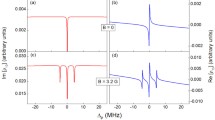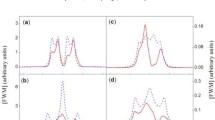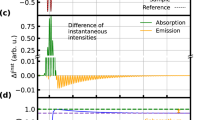Abstract
We present a theoretical model, using density matrix approach, to study the effect of weak as well as strong probe field on the optical properties of an inhomogeneously broadened multilevel V-system of the \(^{87}\)Rb D2 line. We consider the case of stationary as well as moving atoms and perform thermal averaging at room temperature. The presence of multiple excited states results in asymmetric absorption and dispersion profiles. In the weak probe regime, we observe the partial transparency window due to the constructive interference that occurs between transition pathways at the line center. We present our results after carrying out Doppler averaging at room temperature atomic vapor and observe that the line width of transparency window is enhanced, whereas the positive slope of corresponding dispersion curve become less steep. In the presence of strong probe field, the transparency window (with normal dispersion) at line center switches to enhanced absorption (with anomalous dispersion). Here, we also present the dependence of electromagnetically induced transparency on the polarization of applied fields. In the end, we present transient behavior of our system which agrees with corresponding absorption and dispersion profiles. This study may help to understand optical switching and controllability of group velocity.





Similar content being viewed by others
References
K-J Boller, A Imamoğlu and S E Harris Phys. Rev. Lett. 66 2593 (1991)
S E Harris Phys. Today 50 36 (1997)
A S Zibrov et al. Phys. Rev. Lett. 75 1499 (1995)
D Braunstein, G A Koganov and R Shuker J. Phys. B At. Mol. Opt. Phys. 44 235402 (2011)
E Arimondo Prog. Opt. XXXV 257 (1996)
M Fleischhauer, A Imamoglu and J P Marangos Rev. Mod. Phys. 77 663 (2005)
D Budker and M V Romalis Nat. Phys. 3 227 (2007)
S Menon and G S Agarwal Phys. Rev. A 61 013807 (1999)
M Bajcsy et al. Phys. Rev. Lett. 102 203902 (2009)
M Albert, A Dantan and M Drewsen Nat. Photonic 5 633 (2011)
A Krishna, K Pandey, A Wasan and V Natarajan Europhys. Lett. 72 221 (2005)
S E Harris, J E Field and A Imamoğlu Phys. Rev. Lett. 64 1107 (1990)
Y Zhang, B Anderson and M Xiao Phys. Rev. A 77 061801 (2008)
K M Gheri and D F Walls Phys. Rev. A 49 4134 (1994)
M Fleischhauer Phys. Rev. Lett. 72 989 (1994)
G S Agarwal Phys. Rev. Lett. 71 1351 (1993)
C Liu, Z Dutton, C H Behroozi and L V Hau Nature 409 490 (2001)
A K Mohapatra, M G Bason, B Butscher, K J Weatherill and C S Adams Nat. Phys. 4 890 (2008)
L V Hau, S E Harris, Z Dutton and C H Behroozi Nature 397 594 (1999)
L J Wang, A Kuzmich and A Dogariu Nature 406 277 (2000)
A M Akulshin, S Barreiro and A Lezama Phys. Rev. Lett. 83 4277 (1999)
J Mompart, C Peters and R Corbalán Quantum Semiclass. Opt. 10 355 (1998)
A Ray, S Pradhan, K G Manohar and B N Jagatap Laser Phys. 17 1353 (2007)
G R Welch et al. Found. Phys. 28 621 (1998)
J Zhao, L Wang, L Xio, Y Zhao, W Yin and S Jia Opt. Commun. 206 341 (2002)
S Vdović, T Ban, D Aumiler and G Pichler Opt. Commun. 272 407 (2007)
S Mitra, S Dey, M M Hossain, P N Ghosh and B Ray J. Phys. B At. Mol. Opt. Phys. 46 075002 (2013)
A Lazoudis, T Kirova, E H Ahmed, P Qi, J Huennekens and A M Lyyra Phys. Rev. A 83 063419 (2013)
M A Kumar and S Singh Phys. Rev. A 87 065801 (2013)
S D Badger, I G Hughes and C S Adams J. Phys. B At. Mol. Opt. Phys. 34 L749 (2001)
O S Mishina et al. Phys. Rev. A 83 053809 (2011)
V Bharti and A Wasan J. Phys. B At. Mol. Opt. Phys. 45 185501 (2012)
V Bharti and A Wasan Opt. Commun. 324 238 (2014)
P Kaur, V Bharti and A Wasan J. Mod. Opti. 61 1339 (2014)
S J van Enk, J Zhang and P Lambropoulos Phys. Rev. A 50 2777 (1994)
A Raczyński, M Rzepecka, J Zaremba and S Zielińska-Kaniasty Opt. Commun. 266 552 (2006)
K D Quoc, V C Long and W Leoński Phys. Scr. T147 014008 (2012)
T B Dinh, V C Long, W Leoński and J Peřina Jr Eur. Phys. J. D 68 150 (2014)
S Wielandy and A L Gaeta Phys. Rev. A 58 2500 (1998)
K Pandey and V Nataranjan J. Phys. B At. Mol. Opt. Phys. 41 185504 (2008)
K Pandey, D Kaundilya and V Nataranjan Opt. Commun. 284 252 (2011)
M Auzinsh, D Budker and S M Rochester Optically Polarized Atoms, 1st edn. (Oxford: Oxford University press) (2010)
M S Safronova and U I Safronova Phys. Rev. A 83 052508 (2011)
D J Fulton, S Shepherd, R R Moseley, B D Sinclair and M H Dunn Phys. Rev. A 52 2302 (1995)
S Autler and C H Townes Phys. Rev. 100 703 (1955)
P M Anisimov, J P Dowling and B C Sanders Phys. Rev. Lett. 107 163604 (2011)
C Cohen-Tannoudji and S Reynaud J. Phys. B At. Mol. Phys. 10 2311 (1977)
M Yan, E G Rickey and Y Zhu J. Opt. Soc. Am. B 18 1057 (2001)
S M Iftiquar, G R Karve and V Natarajan Phys. Rev. A 77 063807 (2008)
Acknowledgements
PK is thankful to the Ministry of Human Resource Development (MHRD), India for the financial assistance. VB acknowledges financial support from a DS Kothari post-doctoral fellowship of the University Grants Commission, India.
Author information
Authors and Affiliations
Corresponding author
Appendices
Appendix 1: Density matrix equations for a five-level system
In this appendix, we discuss density matrix equations for a five-level system. These density matrix equations can be obtained from Eq. (3) by removing the contribution of the transition \(\left| e_{5} \right\rangle \leftrightarrow \left| g \right\rangle\), in Figure 1(a). This will affect the population of the ground state \(\rho _{gg}\) that will have to modify due to the different decay channels in the resulted five-level system Figure 1(b), so it can be written as
Appendix 2: Dressed-state analysis
In this appendix, we present semiclassical dressed-state picture for a three-level V-system. Our calculations show that for a case \(\varOmega _{cge_{1}} > \varGamma _{e_{4}}\), we observe the partial transparency window at the zero probe detuning. This can be explained by considering the dressed-state analysis of a three-level V-system. The control field couples the states \(\left| g \right\rangle\) and \(\left| e_{1} \right\rangle\) that create two dressed states \(\left| + \right\rangle\) and \(\left| - \right\rangle\);
The probe absorption is from one of these dressed states to an excited state \(\left| e_{4} \right\rangle\), i.e. there are two transition pathways for probe absorption \(\left| e_{4} \right\rangle \rightarrow \left| + \right\rangle\) and \(\left| e_{4} \right\rangle \rightarrow \left| - \right\rangle\). Due to two pathways, there is interfere between them. The transition amplitude at the (undressed) resonant frequency \(\omega _{e_{4}g}=(E_{e_{4}}-E_{g})/\hbar\), from the excited state \(\left| e_{4} \right\rangle\) to the dressed states will be the sum of the contributions to states \(\left| + \right\rangle\) and \(\left| - \right\rangle\), is given by
The transition amplitude is not zero. It means for V-type EIT system, there is a constructive interference between two transition pathways [48] and the probe absorption is enhanced at the zero probe detuning with transition amplitude given by Eq. (12). Due to this reason, we observe only partial transparency window at zero probe detuning for \(\varOmega _{cge_{1}} > \varGamma _{e_{4}}\) case.
Appendix 3: Effect of Doppler shift on susceptibility
In this appendix, we discuss the numerical solution of the imaginary part of susceptibility (\(\rho _{ge_{4}}\)+\(\rho _{ge_{5}}\)) for an atom with the detuning \(\varDelta _{p}\) of the probe field for six-level system with various values of Doppler shift (\(\varDelta _{D}\)).
Our results show that for \(\varDelta _{D}=0\) MHz, there are two transparency windows located at \(\varDelta _{p}=0\) and \(-157\) MHz, as shown in figure 6(a). One of the transparency windows, which is located at \(\varDelta _{p}=-157\) MHz, is due to the level \(e_{5}\). This level \(e_{5}\) is the nearest Zeeman sublevel which is \(-157\) MHz far away from the probe field transition \(\left| g \right\rangle \rightarrow \left| e_{4} \right\rangle\) . When we further increase the Doppler shift, our calculations shows that the shift is negative (red shift) for atoms moving in the same direction as the probe and control fields, and positive (blue shift) for atoms moving opposite to the probe and control fields. It can be seen in figure 6, one of the absorption peaks completely disappear as the Doppler shift increases.
Probe absorption coefficient Im(\(\rho _{ge_{4}}+\rho _{ge_{5}}\)) for atoms as a function of the probe detuning (\(\varDelta _{p}\)) in the weak probe regime with different velocities (a) \(\varDelta _{D} = 0\) MHz, (b) \(\varDelta _{D} = \pm 5\) MHz and (c) \(\varDelta _{D} = \pm 15\) MHz. Solid and dashed curves correspond to the velocity classes with positive Doppler shifts (\(\varDelta _{D}>0\)) and negative Doppler shifts (\(\varDelta _{D}<0\)), respectively. In the present calculations, we take \(\varDelta _{c}=0\) and \(\varOmega _{cge_{1}}=24\) MHz
Rights and permissions
About this article
Cite this article
Kaur, P., Bharti, V. & Wasan, A. Optical properties of an inhomogeneously broadened multilevel V-system in the weak and strong probe regimes. Indian J Phys 91, 1115–1125 (2017). https://doi.org/10.1007/s12648-017-1014-2
Received:
Accepted:
Published:
Issue Date:
DOI: https://doi.org/10.1007/s12648-017-1014-2
Keywords
- Electromagnetically induced transparency
- Doppler-broadened V-system
- Multi-level atom
- Transient properties
- Absorption and dispersion





